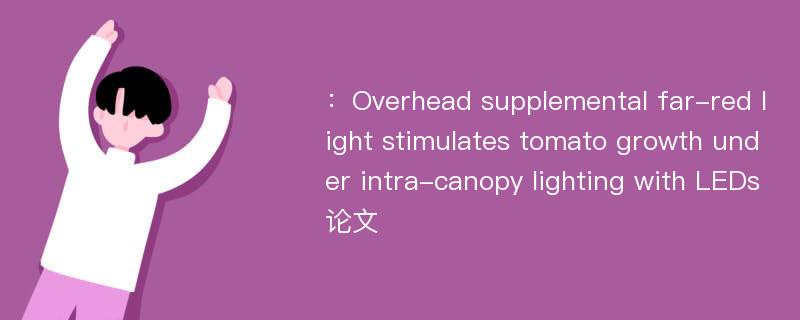
本文主要研究内容
作者(2019)在《Overhead supplemental far-red light stimulates tomato growth under intra-canopy lighting with LEDs》一文中研究指出:Far-red(FR) light regulates phytochrome-mediated morphological and physiological plant responses.This study aims to investigate how greenhouse tomato morphology and production response to different durations of FR light during daytime and at the end of day(EOD).High-wire tomato plants were grown under intra-canopy lighting consisting of red(peak wavelength at 640 nm) and blue(peak wavelength at 450 nm) light-emitting diodes(LEDs) with photosynthetic photon flux density(PPFD) of 144 μmol m–2 s–1 at 10 cm away from the lamps,and combined with overhead supplemental FR light(peak wavelength at 735 nm) with PPFD of 43 μmol m–2 s–1 at 20 cm below the lamps.Plants were exposed to three durations of FR supplemental lighting including: 06:00–18:00(FR12),18:00–19:30(EOD-FR1.5),18:00–18:30(EOD-FR0.5),and control that without supplemental FR light.The results showed that supplemental FR light significantly stimulated stem elongation thereby resulting in longer plants compared with the control.Moreover,FR light altered leaf morphology toward higher leaf length/width ratio and larger leaf area.The altered plant architecture in FR supplemented plants led to a more homogeneous light distribution inside the canopy.Total plant biomass was increased by 9–16% under supplemental FR light in comparison with control,which led to 7–12% increase in ripe fruit yield.Soluble sugar content of the ripe tomato fruit was slightly decreased by longer exposure of the plants to FR light.Dry matter partitioning to different plant organs were not substantially affected by the FR light treatments.No significant differences were observed among the three FR light treatments in plant morphology as well as yield and biomass production.We conclude that under intra-canopy lighting,overhead supplemental FR light stimulates tomato growth and production.And supplementary of EOD-FR0.5 is more favorable,as it consumes less electricity but induces similar effects on plant morphology and yield.
Abstract
Far-red(FR) light regulates phytochrome-mediated morphological and physiological plant responses.This study aims to investigate how greenhouse tomato morphology and production response to different durations of FR light during daytime and at the end of day(EOD).High-wire tomato plants were grown under intra-canopy lighting consisting of red(peak wavelength at 640 nm) and blue(peak wavelength at 450 nm) light-emitting diodes(LEDs) with photosynthetic photon flux density(PPFD) of 144 μmol m–2 s–1 at 10 cm away from the lamps,and combined with overhead supplemental FR light(peak wavelength at 735 nm) with PPFD of 43 μmol m–2 s–1 at 20 cm below the lamps.Plants were exposed to three durations of FR supplemental lighting including: 06:00–18:00(FR12),18:00–19:30(EOD-FR1.5),18:00–18:30(EOD-FR0.5),and control that without supplemental FR light.The results showed that supplemental FR light significantly stimulated stem elongation thereby resulting in longer plants compared with the control.Moreover,FR light altered leaf morphology toward higher leaf length/width ratio and larger leaf area.The altered plant architecture in FR supplemented plants led to a more homogeneous light distribution inside the canopy.Total plant biomass was increased by 9–16% under supplemental FR light in comparison with control,which led to 7–12% increase in ripe fruit yield.Soluble sugar content of the ripe tomato fruit was slightly decreased by longer exposure of the plants to FR light.Dry matter partitioning to different plant organs were not substantially affected by the FR light treatments.No significant differences were observed among the three FR light treatments in plant morphology as well as yield and biomass production.We conclude that under intra-canopy lighting,overhead supplemental FR light stimulates tomato growth and production.And supplementary of EOD-FR0.5 is more favorable,as it consumes less electricity but induces similar effects on plant morphology and yield.
论文参考文献
论文详细介绍
论文作者分别是来自Journal of Integrative Agriculture的,发表于刊物Journal of Integrative Agriculture2019年01期论文,是一篇关于,Journal of Integrative Agriculture2019年01期论文的文章。本文可供学术参考使用,各位学者可以免费参考阅读下载,文章观点不代表本站观点,资料来自Journal of Integrative Agriculture2019年01期论文网站,若本站收录的文献无意侵犯了您的著作版权,请联系我们删除。
